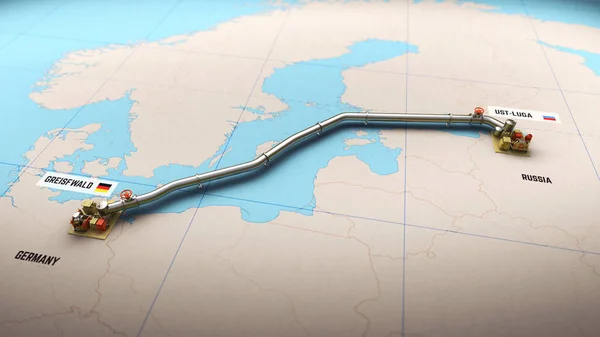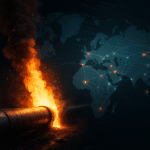Energy infrastructure has become one of the most contested arenas in modern geopolitical conflict. Pipelines, refineries, LNG terminals, and undersea cable networks are not just economic lifelines—they are strategic targets. As global tensions rise, these systems are increasingly vulnerable to sabotage, cyberattacks, insurgent operations, and hybrid warfare.
From the Nord Stream pipeline explosions in the Baltic Sea to militant assaults in Nigeria and cyberattacks like the Colonial Pipeline breach, energy infrastructure is now caught in the crossfire of 21st-century power struggles. These are not random disruptions—they are deliberate strikes designed to coerce, destabilize, and reshape the global balance of power.
The Nord Stream Explosions: A New Era in Undersea Warfare
On September 26, 2022, the world witnessed a turning point in infrastructure warfare. Powerful underwater explosions ruptured the Nord Stream 1 and 2 pipelines, cutting a vital gas supply route from Russia to Europe. These twin pipelines stretched more than 750 miles beneath the Baltic Sea—assumed secure due to their remote placement and engineering.
The blasts changed that perception overnight.
Intelligence agencies across Europe and North America launched investigations. Suspicions ranged from state-sponsored special operations teams to independent sabotage cells with high-grade underwater capabilities. Yet, no definitive actor has been named.
What is clear: undersea energy infrastructure is now a battlefield.
The economic impact was immediate. Gas prices surged. European governments scrambled for alternative supply chains. NATO and EU forces increased surveillance of critical underwater assets—pipelines, undersea internet cables, and power interconnectors.
The Nord Stream attack also revealed the West’s vulnerability. With sufficient equipment—ROVs, divers, timed charges—adversaries can now hit strategic infrastructure quietly and anonymously. The incident sent a message to Russia, NATO, and the world: the depths of the ocean are no longer off-limits.
Colonial Pipeline: A Cyber Strike on U.S. Energy Infrastructure
While physical attacks dominate the headlines, cyberattacks have emerged as an equally potent threat to energy infrastructure. The Colonial Pipeline ransomware attack in May 2021 marked one of the most significant cyber disruptions in U.S. history.
A criminal group known as DarkSide infiltrated Colonial’s IT network, forcing the company to shut down 5,500 miles of fuel pipeline supplying nearly half of the fuel consumed along the U.S. East Coast. The resulting chaos included widespread fuel shortages, panic buying, and cascading disruptions in logistics and aviation.
Colonial paid a $4.4 million ransom in Bitcoin, though U.S. authorities later recovered a portion of the funds.
This attack was a wake-up call. It exposed glaring cybersecurity weaknesses across America’s energy grid. Unlike physical sabotage, cyberattacks require no proximity, and attackers can strike from any continent. State-sponsored hacker groups from Russia, China, Iran, and North Korea have already demonstrated that digital warfare can disable critical infrastructure with near impunity.
Cybersecurity is no longer a technical concern—it’s now a national security priority.
Nigeria’s Pipeline Wars: The Underrated Insurgency
In the Niger Delta, Nigeria’s oil-rich southern region, pipelines have become battlegrounds in one of the longest-running sabotage campaigns on Earth. Armed groups such as the Niger Delta Avengers and smaller militant factions have systematically attacked oil pipelines to disrupt production, steal crude, and pressure the government for political and economic concessions.
These attacks have, at times, cut Nigeria’s oil output by nearly 50 percent, devastating government revenues and affecting global oil prices. In 2016, oil majors including Shell and ExxonMobil temporarily shut down operations due to security risks.
The Nigerian case shows how insurgent movements can weaponize infrastructure. Pipelines in volatile regions become bargaining chips—tools of coercion, disruption, and rebellion. Even when production resumes, the long-term damage to investor confidence and national infrastructure lingers for years.
Despite military crackdowns and peace agreements, pipeline sabotage in Nigeria remains rampant, often driven by local grievances, ethnic conflict, and resource control disputes.
Mexico’s 2019 Pipeline Explosion: Fuel Theft as Infrastructure Threat
Sabotage isn’t always political. Sometimes, it’s driven by organized crime and economic desperation.
On January 18, 2019, in the town of Tlahuelilpan, Mexico, an illegal tap on a Pemex fuel pipeline led to an explosion that killed 137 people. Hundreds of civilians had gathered to collect gasoline from a leaking pipe, unaware of the risk.
The explosion shocked the nation. But it was not an isolated incident.
Fuel theft in Mexico—known as huachicolero activity—has become a billion-dollar black market industry. Criminal organizations tap state-owned pipelines, siphoning gasoline and diesel to resell illegally. The government estimates that fuel theft drains more than $3 billion annually from the national economy.
The Tlahuelilpan disaster revealed the risks of poor pipeline security, lack of local economic opportunity, and the power of organized crime in targeting infrastructure. Protecting energy networks in such contexts requires not only physical deterrents, but also community engagement, anti-corruption measures, and stronger legal enforcement.
Hybrid Threats in the Baltic and Pacific Theaters
Energy infrastructure is no longer limited to above-ground targets. Undersea networks—both for energy and data—are now critical to national security.
In 2023, a string of mysterious disruptions hit undersea internet and energy cables in the Baltic Sea. NATO intelligence agencies raised alarms, pointing to Russian naval activity and submarine-based sabotage as possible causes. While no state has claimed responsibility, the incidents fit a broader pattern of hybrid warfare operations.
In the Pacific, Taiwan faces similar threats. The island relies on 14 undersea communication cables, several of which were damaged in recent years by unknown actors. Suspicion has fallen on Chinese operations, possibly preparing for future military contingencies by cutting Taiwan off digitally.
If conflict erupts in the Taiwan Strait, experts believe that LNG routes and undersea networks will be among the first targets. These chokepoints represent soft infrastructure—essential but hard to protect.
The race to defend these assets is already underway. NATO, Japan, Australia, and U.S. forces have increased investment in undersea surveillance, cable mapping, and rapid repair capabilities.
How Insurgents Weaponize Pipelines
Around the world, insurgents and non-state actors increasingly target pipelines as tools of asymmetric warfare. The appeal is clear:
- Pipelines generate high economic impact for relatively low-risk sabotage.
- They offer revenue streams when captured or siphoned.
- They serve as symbols of state power—making them high-value targets.
Groups such as ISIS in Syria, the Taliban in Afghanistan, and Houthi rebels in Yemen have all targeted oil and gas infrastructure. By hitting these assets, they achieve multiple goals: draining state resources, undermining legitimacy, and drawing global media attention.
As governments focus on military threats, they must now expand protection protocols to include insurgents, cartels, and cybercriminals, all of whom are adapting faster than many states can respond.
The Arctic: The Final Energy Frontier
Far from traditional conflict zones, a quiet energy arms race is unfolding in the Arctic. As ice melts and access improves, nations like Russia, the United States, Canada, and China are racing to control untapped oil and gas reserves beneath the seabed.
Russia has made the boldest moves, launching the Yamal LNG project and expanding Arctic patrols. China, while not an Arctic nation, has declared itself a “near-Arctic power” and invested heavily in infrastructure projects and icebreaker fleets.
Meanwhile, NATO has increased operations in the region, turning the Arctic into a new stage for great-power competition.
Future conflict in the Arctic may not look like traditional war. It may involve blockades of energy routes, control of infrastructure, and legal battles over continental shelves. As energy supply routes open in the north, pipeline security in this frozen frontier will become a central concern for the 21st century.
How to Defend Energy Infrastructure in the 21st Century
Defending energy infrastructure in an age of hybrid warfare demands more than just guards and fences. As adversaries adopt new tools—ranging from cyberattacks and sabotage to legal manipulation and economic coercion—states and corporations must implement multi-layered, integrated security strategies. The future of energy security will hinge on the ability to combine physical protection, digital resilience, strategic foresight, and systemic adaptability.
Physical Security: Hardening the Front Lines
Physical defense remains the first layer of protection for pipelines, refineries, LNG terminals, and energy transport corridors. Especially in conflict-prone or politically unstable regions, hardened perimeters with fencing, blast barriers, and secured access points are essential.
However, deterrence requires more than static defenses. High-resolution surveillance systems, including drones, thermal cameras, and motion sensors, allow operators to monitor vast stretches of infrastructure in real time. Equally important are rapid-response teams—mobile units trained to contain incidents, repair damage, and counter on-site threats.
For underwater assets, the challenge is even greater. Subsea pipelines, energy platforms, and communication cables now require a blend of naval patrols, sonar arrays, and remotely operated vehicles (ROVs) to detect and neutralize sabotage attempts. As the Nord Stream explosions demonstrated, even deep-sea infrastructure is no longer safe by default.
Cybersecurity: Resilience in the Digital Domain
With the rise of ransomware, zero-day exploits, and state-sponsored hacking groups, cybersecurity has become mission-critical for energy infrastructure protection. Unlike physical attacks, cyber intrusions can occur without warning and from thousands of miles away.
To mitigate these threats, energy operators must deploy real-time threat detection systems powered by artificial intelligence and machine learning. These platforms analyze patterns of network behavior and flag anomalies that may indicate intrusion.
Air-gapped control systems (isolated from internet-facing networks) remain a best practice for high-risk sites, particularly those that control pressure valves, gas flow, and emergency shutdown functions. However, even air-gapped systems are not immune to insider threats or advanced malware like Stuxnet.
Organizations should also conduct frequent cybersecurity drills that simulate ransomware scenarios, phishing campaigns, and distributed denial-of-service (DDoS) attacks. Building response playbooks ensures that IT teams, plant operators, and executives are prepared to act quickly and limit damage.
Geopolitical Foresight: Seeing the Broader Battlefield
Energy infrastructure exists within—and often defines—the global balance of power. Geopolitical risk awareness is essential to infrastructure defense.
Strategic coordination among allies is key. Organizations such as NATO, the European Union, and the Five Eyes intelligence alliance have already begun integrating shared threat tracking, joint response protocols, and cross-border sabotage alert systems. Expanding these frameworks can improve early warning and reinforce deterrence.
At the same time, international maritime law and undersea infrastructure protection protocols are outdated and insufficiently enforced. Global policymakers must update legal regimes governing territorial waters, seabed resources, and undersea cable security to reflect the reality of hybrid warfare.
Foresight also includes economic policy. Energy-producing nations should anticipate adversary tactics such as sanctions evasion, coercive energy pricing, and gray-zone energy disruption and prepare contingency plans.
Redundancy and Diversification: Building Infrastructure That Can Absorb the Blow
No infrastructure is invulnerable—but some networks are more resilient than others. Redundancy and diversification are key to minimizing the impact of any single point of failure.
First, diversify energy import routes and export corridors. Reliance on one pipeline, one shipping lane, or one LNG terminal creates a single point of failure that adversaries can exploit. By developing regional interconnectors, LNG port networks, and cross-border supply flexibility, governments can prevent economic paralysis if infrastructure is targeted.
Second, decentralize. The future of energy security lies in distributed generation. Local solar, wind, battery storage, and microgrid infrastructure can help communities remain functional even if national pipelines or power plants are compromised.
In parallel, build redundant digital systems and mirrored backups to prevent service disruption in the event of a cyberattack. Cloud-based infrastructure, secure off-site storage, and automated switchover protocols can protect operational continuity.
Finally, adopt a layered, modular approach to both generation and transmission. Modular energy systems can be isolated, rerouted, or scaled based on threat posture—offering a flexible defensive posture in an increasingly uncertain global environment.
Defending Infrastructure in the Shadow War
The battle over energy infrastructure won’t be won with force alone. It requires intelligence sharing, real-time surveillance, AI-enhanced threat detection, public-private coordination, and long-term investment in resilient systems.
As adversaries blend physical, digital, and psychological tactics, defense must evolve just as rapidly. Energy infrastructure is no longer just an economic asset—it is a strategic battlefield where national security, geopolitical influence, and survival intersect.
Conclusion: Infrastructure as a Theater of War
From the Nord Stream sabotage to cyberattacks on U.S. pipelines and armed assaults in Nigeria, one thing is clear: infrastructure is the new frontline of global conflict.
Energy pipelines, undersea cables, and supply chains are no longer neutral—they are targets in the shadow wars of the 21st century. As nation-states, insurgents, and cyber actors continue to weaponize infrastructure, the task of securing these vital assets grows more urgent by the day.
To track the evolving threats to global energy systems and understand how they intersect with irregular warfare, state power, and non-state actors, follow The Resistance Hub for expert analysis and real-time insights.
DISCLAIMER: Links included might be affiliate links. If you purchase a product or service with the links that I provide I may receive a small commission. There is no additional charge to you.





Leave a Reply